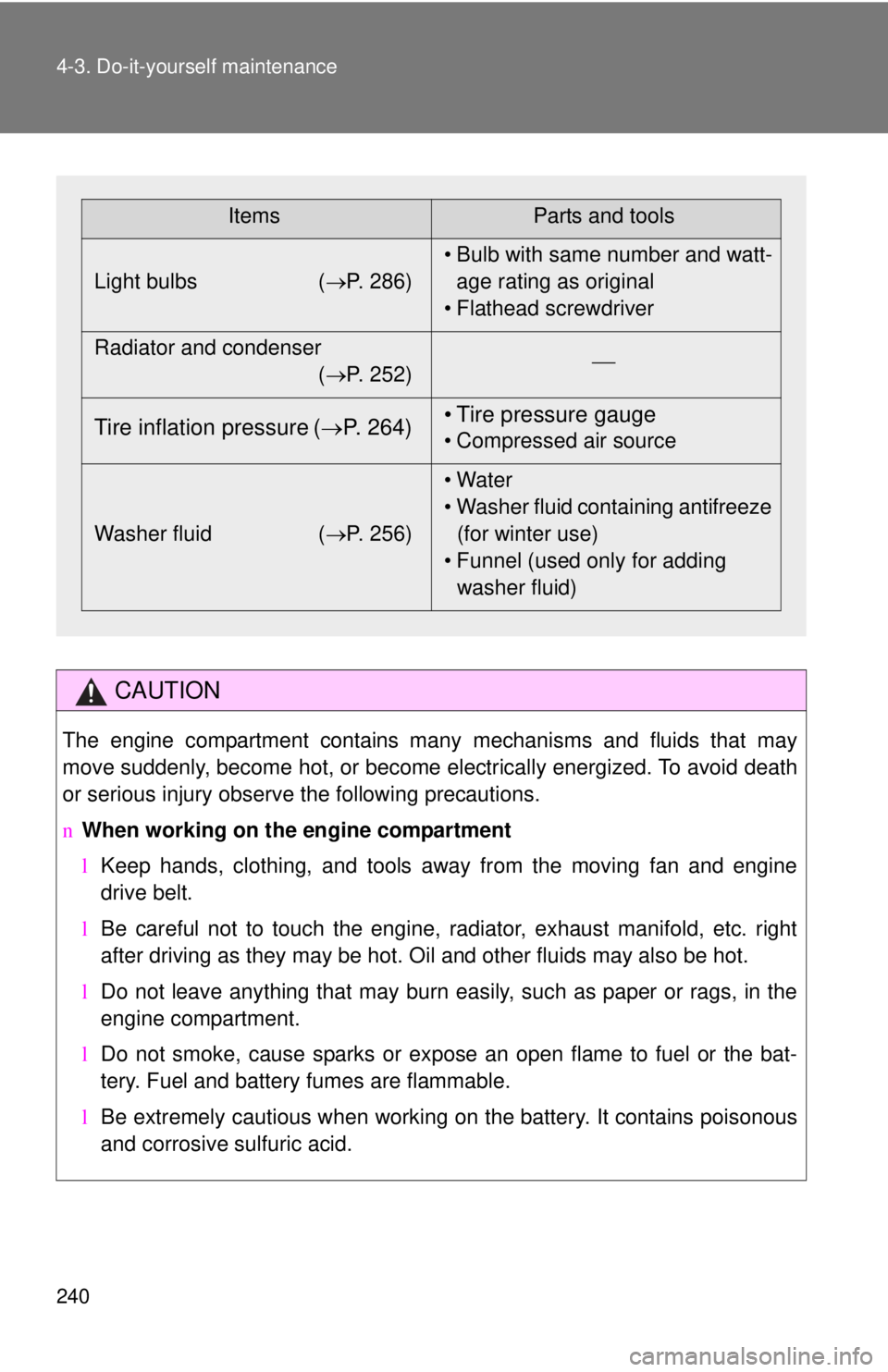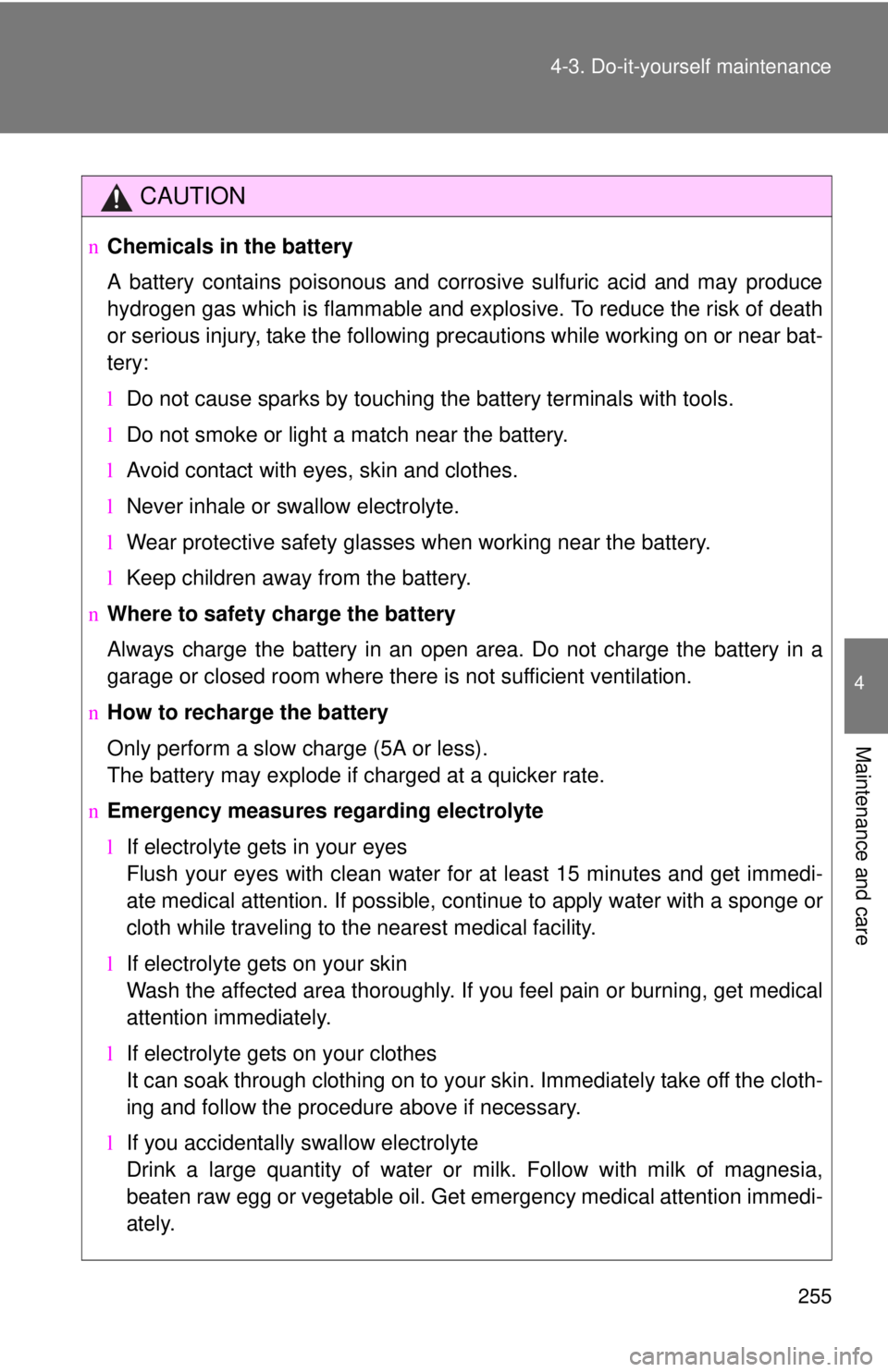Page 251 of 402

240 4-3. Do-it-yourself maintenance
CAUTION
The engine compartment contains many mechanisms and fluids that may
move suddenly, become hot, or become electrically energized. To avoid death
or serious injury observe the following precautions.
nWhen working on the engine compartment
lKeep hands, clothing, and tools away from the moving fan and engine
drive belt.
l Be careful not to touch the engine, radiator, exhaust manifold, etc. right
after driving as they may be hot. Oil and other fluids may also be hot.
l Do not leave anything that may burn easily, such as paper or rags, in the
engine compartment.
l Do not smoke, cause sparks or expose an open flame to fuel or the bat-
tery. Fuel and battery fumes are flammable.
l Be extremely cautious when working on the battery. It contains poisonous
and corrosive sulfuric acid.
ItemsParts and tools
Light bulbs ( →P. 286)• Bulb with same number and watt-
age rating as original
• Flathead screwdriver
Radiator and condenser
( →P. 252) ⎯
Tire inflation pressure (
→P. 264) • Tire pressure gauge• Compressed air source
Washer fluid ( →P. 256)• Water
• Washer fluid containing antifreeze
(for winter use)
• Funnel (used only for adding washer fluid)
Page 256 of 402
245
4-3. Do-it-yourself maintenance
4
Maintenance and care
Engine compar tment
Washer fluid tank (→P. 256)
Engine oil filler cap
( → P. 246)
Engine oil level dipstick
( → P. 246)
Radiator cap
Battery ( →P. 253)
Brake fluid reservoir
( → P. 252)Fuse box ( →P. 275)
Condenser ( →P. 252)
Electric cooling fan
Engine coolant reservoir
( → P. 250)
Radiator ( →P. 252)
Page 264 of 402
253
4-3. Do-it-yourself maintenance
4
Maintenance and care
.
Battery
n
Battery exterior
Make sure that the battery terminals are not corroded and that
there
are no loose connections, cracks, or loose clamps.
Te r m i n a l s
Hold-down clamp
CAUTION
nWhen filling the reservoir
Take care because brake fluid can harm your hands or eyes and damage
painted surfaces.
If fluid gets on your hands or in your eyes, flush the affected area with clean
water immediately.
If you still experience discomfort, see a doctor.
NOTICE
nIf the fluid level is low or high
It is normal for the brake fluid level to go down slightly as the brake pads
wear or when the fluid level in the accumulator is high.
If the reservoir needs frequent refilling, it may indicate a serious pro\
blem.
n If you spill fluid
Be sure to wash it off with water to prevent damage to parts or paint.
Page 265 of 402
254 4-3. Do-it-yourself maintenance
nChecking battery condition
Check the battery condition using the indicator color.
Type A
Blue: Good condition
White: Charging is necessary.
Have the vehicle inspected by
your
Toyota dealer.
Red: Not working properly,
have the battery checked by
your
Toyota dealer.
Type B Green: Good condition
Dark: Charging is necessary.
Have the vehicle inspected by
your
Toyota dealer.
Clear or light yellow: Not
working properly, have the
b
attery checked by your
Toyota dealer.
n Before recharging
When recharging, the battery produces hydrogen gas which is flammable
and explosive. Therefore, before recharg
ing:
l If
recharging with the battery installed on the vehicle, be sure to discon -
nect the ground cable.
l Mak
e sure the power switch on the charger is off when connecting and
disconnecting the charger cables to the battery.
Page 266 of 402

255
4-3. Do-it-yourself maintenance
4
Maintenance and care
CAUTION
n
Chemicals in the battery
A battery contains poisonous and corrosive sulfuric acid and may produce
hydrogen gas which is flammable and explosive. To reduce the risk of death
or serious injury, take the following precautions while working on or near bat-
tery:
l Do not cause sparks by touching the battery terminals with tools.
l Do not smoke or light a match near the battery.
l Avoid contact with eyes, skin and clothes.
l Never inhale or swallow electrolyte.
l Wear protective safety glasses when working near the battery.
l Keep children away from the battery.
n Where to safety charge the battery
Always charge the battery in an open area. Do not charge the battery in a
garage or closed room where there is not sufficient ventilation.
n How to recharge the battery
Only perform a slow charge (5A or less).
The battery may explode if charged at a quicker rate.
n Emergency measures regarding electrolyte
lIf electrolyte gets in your eyes
Flush your eyes with clean water for at least 15 minutes and get immedi-
ate medical attention. If possible, continue to apply water with a sponge or
cloth while traveling to the nearest medical facility.
l If electrolyte gets on your skin
Wash the affected area thoroughly. If you feel pain or burning, get medical
attention immediately.
l If electrolyte gets on your clothes
It can soak through clothing on to your skin. Immediately take off the cloth-
ing and follow the procedure above if necessary.
l If you accidentally swallow electrolyte
Drink a large quantity of water or milk. Follow with milk of magnesia,
beaten raw egg or vegetable oil. Get emergency medical attention immedi-
ately.
Page 267 of 402
256 4-3. Do-it-yourself maintenance
Washer fluid
If any washer does not work or the low washer fluid warning light
comes on (if equipped), the washer tank may be empty.
Open the lid.
Add washer fluid.
NOTICE
nWhen recharging the battery
Never recharge the battery while the engine is running. Also, be sure all
accessories are turned off.
Page 284 of 402
273
4-3. Do-it-yourself maintenance
4
Maintenance and care
Key batter y
Replace the battery with a new one if it is discharged.
nYou will need the following items:
lFla
thead screwdriver (To prevent damage to the key, cover
the tip of the screwdriver with plastic tape.)
l Lith
ium battery CR2016
n Replacing the battery
Remove the cover.
Remove the module.
Remove the battery cover and
the de
pleted battery.
Insert a new battery with the
“+” terminal facing up.
Page 285 of 402
274 4-3. Do-it-yourself maintenance
nIf the key battery is discharged
The following symptoms may occur.
lThe wi
reless remote control will not function properly.
lThe operational range is reduced.
n Use a CR2016 lithium battery
l Batteries can be p
urchased at your Toyota dealer, jewelers, or camera
stores.
l Replace only with the same or equivalent type
recommended by your
Toyota dealer.
l Dispose of used batteries according to the local laws.
CAUTION
nRemoved battery and other parts
Keep away from children.
These parts are small and if swallowed by a child they can cause choking.
NOTICE
n For normal operation after replacing the battery
Observe the following precautions to prevent accidents.
lAlways work with dry hands.
Moisture may cause the battery to rust.
l Do not touch or move any other components inside the remote control.
l Do not bend either of the battery terminals.